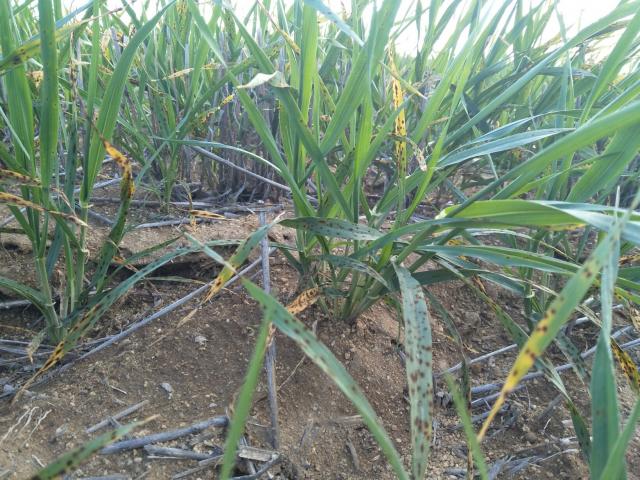Background
Spot type net blotch (STNB) is a foliar disease of barley found across the wheatbelt. It is most damaging in medium-high rainfall regions of WA; however, the disease is still seen in the eastern wheatbelt. The disease is stubble borne so cropping continuous barley poses the greatest risk of disease, especially given that most varieties are susceptible.
Yield and grain quality impacts of the disease are usually worst when disease development in upper canopy is supported by spring rainfall; in conducive environments STNB can cause up to 44% yield loss and significantly increase screenings. Foliar fungicides can provide protection against yield losses, however responses to fungicide are influenced by disease severity and seasonal conditions.
In 2017 a grower scale demonstration was set up in Muntadgin to investigate the economic return of spraying fungicide for spot type net blotch in a low rainfall environment.
Trial details
The paddock was chosen opportunistically as it was continuous barley and had comparatively higher levels of spot type net blotch than other paddocks in the region. The demonstration was managed as per standard grower practice with the exception of six lengths of 48m where foliar fungicide was not applied.
Each plot was assessed for yield and grain quality with five hand cuts 1m2 in size.
| Rotation | 2016 barley cv. Litmus (STNB rating- S seedling and adult) 2017 barley cv. Spartacus (STNB rating- SVS seedling; S adult) |
|---|---|
| Seed dressing | 1L/ t Vincit C (25g/L flutriafol, 4g/L cypermethrin) |
| Seeding rate | 60kg/ha |
| Row spacing | 9 inch |
| Seeding date | 10 May 2017 |
| Fungicide treatment | 250mL/ha Tilt (250g/L propiconazole) applied 11 July at approximately growth stage 32 |
Results and discussion
Disease
At the time of fungicide application STNB disease levels were at 7% leaf area affected, across the top four leaves.
Foliar fungicide application significantly reduced STNB disease levels on the flag-1, -2 and -3 leaves (Table 1).
STNB disease severity was reduced by approximately 40–45% in the sprayed plots, however some disease was still evident in sprayed plots, particularly at 8 weeks after sowing (longer periods of protection can be provided by spraying at later growth stages, double applications or use of higher rates).
Despite there being a significant difference in disease levels, the overall disease levels in this paddock in 2017 were still quite low.
| Treatment | Flag leaf | Flag-1 | Flag-2 | Flag-3 | Average (in top four leaves) |
|---|---|---|---|---|---|
| sprayed | 0 | 0.2 | 2.7 | 8.1 | 2.8 |
| unsprayed | 0.04 | 1.3 | 6.6 | 15.4 | 5.8 |
| LSD | ns | 0.4 | 1.4 | 2.7 |
| Treatment | Flag leaf | Flag-1 | Flag-2 | Flag-3 | Average (in top four leaves) |
|---|---|---|---|---|---|
| sprayed | 2.4 | 4.3 | 7.5 | 14.7 | 7.2 |
| unsprayed | 4.3 | 6.2 | 11.6 | 26.2 | 12.1 |
| LSD | ns | 1.4 | 2.3 | 6.9 |
LSD = least significant difference; ns = not significant
Yield and quality
Despite the disease reduction in the fungicide sprayed plots, there was no corresponding yield or grain quality benefit from spraying (figures 1 and 2).
Trials by Hills et al. (2016) have also shown that, even if a fungicide application reduces STNB severity, there is not always a yield response (refer to 2016 GRDC Grains Research Updates paper Yield response to fungicide control of barley spot type net blotch in Western Australia). The yield impact of STNB and the response to fungicide application are dependent on seasonal weather conditions supporting disease development.
The low rainfall experienced throughout the 2017 growing season in the eastern wheatbelt was less conducive to STNB which may have also contributed to the lack of yield response in this demonstration. Other eastern wheatbelt trials in recent seasons have shown yield responses (100–300kg/ha) to fungicide application when seasonal conditions were more favourable for disease development in spring.
In some cases it is possible for screenings to be negatively impacted by STNB even though yield is not, however in this demonstration screenings were not affected (9.8% screenings in sprayed plots compared to 10.3% in unsprayed).
The lack of yield penalty from not applying fungicide meant that there was no return on investment for spraying for STNB in Muntadgin in 2017. However, spraying for STNB in one season may reduce the disease inoculum for the subsequent season.
Further work needs to be done to investigate the effects of spraying on disease burden in the following season if the paddock is re-sown to barley.
Acknowledgments
Thank you to the Kerse family for hosting and managing the demonstration.
GRDC Project Number: DAW00256 (Building crop protection and crop production agronomy research and development capacity in regional Western Australia).
Cam Wild (DPIRD) and Irena Rodenburg for assistance with hand cuts and processing samples.

